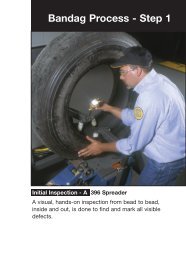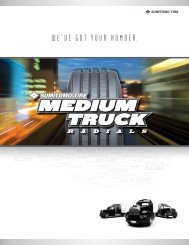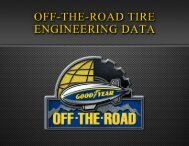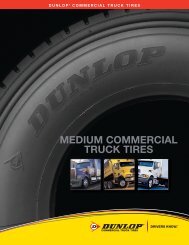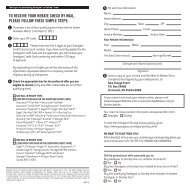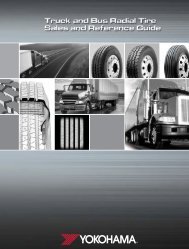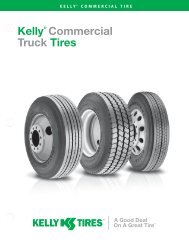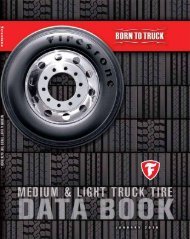Bridgestone Medium and Light Truck Tire Data Book - Sullivan Tire ...
Bridgestone Medium and Light Truck Tire Data Book - Sullivan Tire ...
Bridgestone Medium and Light Truck Tire Data Book - Sullivan Tire ...
Create successful ePaper yourself
Turn your PDF publications into a flip-book with our unique Google optimized e-Paper software.
Technical Bulletins Load/Inflation General Technical <strong>Light</strong> <strong>Truck</strong> <strong>Medium</strong> <strong>Truck</strong><br />
General Technical Information<br />
<strong>Tire</strong> <strong>and</strong> wheel imbalance may result in irregular tire<br />
wear. Steering axle <strong>and</strong> drive axle tires should be<br />
balanced dynamically for best results. Vibration may<br />
also be the result of mismatch of the high <strong>and</strong> low<br />
spots of the tire <strong>and</strong> wheel.<br />
To resolve vibration problems, the runout of tire<br />
<strong>and</strong> rim should be measured, then matched in the<br />
following manner:<br />
N. Balance/Runout<br />
1. With the tire mounted on the rim, number both at<br />
12 asymmetrical points.<br />
2. Measure runout at both shoulders of the tire (inside<br />
& outside) <strong>and</strong> record the results. (Note: accuracy<br />
in these measurements is essential.)<br />
3. Demount the tire, measure both sides of the rim for<br />
runout, record the results, then average the inside<br />
<strong>and</strong> outside measurements.<br />
4. Matching the lowest average point of the rim to the<br />
highest average point of the tire, remount the tire,<br />
then balance accurately.<br />
5. It may be necessary to repeat this procedure since<br />
the tire cannot be measured accurately while on an<br />
imperfect rim.<br />
Note: If a runout dial is not available, rotate the<br />
tire 180° relative to the rim <strong>and</strong> remount. If the<br />
vibration persists, rotate the tire another 90°, then<br />
another 180°.<br />
6. The maximum suggested radial runout for a<br />
rotating tire/wheel assembly is 0.095 inches for<br />
both front <strong>and</strong> rear tire positions. If runout exceeds<br />
these limits, check for bent rims, cocked rims,<br />
improperly adjusted wheel bearings, improper tire<br />
bead seating, tire flat spots, improperly tightened<br />
rim clamps <strong>and</strong> rear rim spacers.<br />
Special procedure for improving steering tire run-out on vehicles<br />
with hub-piloted wheels<br />
If you suspect high run-out on the steering position <strong>and</strong><br />
have hub-piloted wheels, use the following procedure<br />
to improve the radial run-out.<br />
1. Measure the radial run-out of the tire/wheel<br />
assemblies on the vehicle’s steering position. Mark<br />
the highest <strong>and</strong> lowest points of the radial run-out<br />
on the tire with chalk or other marker.<br />
2. Remove the tire/wheel assembly <strong>and</strong> position the<br />
hub so that the gap between any two of the hub<br />
pilot pads is at 12:00. With the hub in this position<br />
place the tire/wheel assembly on the hub so that<br />
the high point mark is at the top (12:00). Carefully<br />
tighten one nut with a h<strong>and</strong> wrench until it is snug<br />
enough to hold the wheel securely. Reposition the<br />
2010 <strong>Bridgestone</strong> <strong>Medium</strong> <strong>and</strong> <strong>Light</strong> <strong>Truck</strong> <strong>Tire</strong> <strong>Data</strong> <strong>Book</strong><br />
Runout of rim<br />
Runout of tire<br />
Runout of <strong>Tire</strong> Due to<br />
Runout of Rim<br />
Proper Position for<br />
Measuring Runout<br />
76



